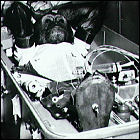 Prior to putting an astronaut in orbit, NASA launches a chimpanzee named Enos on a two-orbit Mercury flight to validate the survivability of the spacecraft for an extended flight. Enos is recalled to Earth when both his spacesuit and his Mercury capsule begins heating up unexpectedly, and attitude control is lost; after three hours and two orbits, Mercury 5 returns to Earth. While hauling the capsule from the ocean, recovery crews accidentally crack the window. Despite all this, Enos is safely returned home; he dies a year later from an illness not related to his orbital flight.
Prior to putting an astronaut in orbit, NASA launches a chimpanzee named Enos on a two-orbit Mercury flight to validate the survivability of the spacecraft for an extended flight. Enos is recalled to Earth when both his spacesuit and his Mercury capsule begins heating up unexpectedly, and attitude control is lost; after three hours and two orbits, Mercury 5 returns to Earth. While hauling the capsule from the ocean, recovery crews accidentally crack the window. Despite all this, Enos is safely returned home; he dies a year later from an illness not related to his orbital flight.

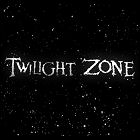 The 77th episode of Rod Serling’s The Twilight Zone airs on CBS. John Dehner and Walter Brooke star.
The 77th episode of Rod Serling’s The Twilight Zone airs on CBS. John Dehner and Walter Brooke star.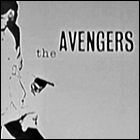 The 23rd episode of Sydney Newman’s spy series The Avengers, starring Ian Hendry and Patrick Macnee, airs on UK broadcaster ABC. This episode is now missing from the archives, but will be recreated in audio form in the 21st century by Big Finish Productions.
The 23rd episode of Sydney Newman’s spy series The Avengers, starring Ian Hendry and Patrick Macnee, airs on UK broadcaster ABC. This episode is now missing from the archives, but will be recreated in audio form in the 21st century by Big Finish Productions.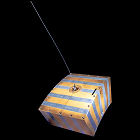 OSCAR-1, an experimental satellite designed and built by amateur radio engineers for a technology test, is launched as a secondary payload aboard an Air Force rocket whose primary payload is a reconnaissance satellite. This is the first launch in history with a secondary payload, and the first payload not developed by a specific government or its agencies. The amateur radio engineers of Project OSCAR built the simple transmitter satellite for a grand total of $35, with a finite battery life and no attitude control thrusters of any kind, to transmit the message “HI” in the 2-meter band until the battery expired (which happens a few weeks before the satellite re-enters Earth’s atmosphere in late January 1962). A nearly-identical OSCAR-2 satellite will be launched in June 1962, while OSCAR-3, launched in 1965, is capable of receiving and retransmitting signals.
OSCAR-1, an experimental satellite designed and built by amateur radio engineers for a technology test, is launched as a secondary payload aboard an Air Force rocket whose primary payload is a reconnaissance satellite. This is the first launch in history with a secondary payload, and the first payload not developed by a specific government or its agencies. The amateur radio engineers of Project OSCAR built the simple transmitter satellite for a grand total of $35, with a finite battery life and no attitude control thrusters of any kind, to transmit the message “HI” in the 2-meter band until the battery expired (which happens a few weeks before the satellite re-enters Earth’s atmosphere in late January 1962). A nearly-identical OSCAR-2 satellite will be launched in June 1962, while OSCAR-3, launched in 1965, is capable of receiving and retransmitting signals.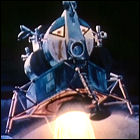 Weeks before an American astronaut first makes it to orbit, NASA unveils the design of the two Apollo spacecraft: a command/service module (large compared to the Mercury capsules Americans have already seen) and a completely un-aerodynamic lunar module whose unique shape, designed solely for landing on the moon, will never need to operate inside an atmosphere. Though further refinements in both designs are still to come, NASA has already decided on the basic shape of its crash lunar exploration program whose goal is to land a man on the moon before
Weeks before an American astronaut first makes it to orbit, NASA unveils the design of the two Apollo spacecraft: a command/service module (large compared to the Mercury capsules Americans have already seen) and a completely un-aerodynamic lunar module whose unique shape, designed solely for landing on the moon, will never need to operate inside an atmosphere. Though further refinements in both designs are still to come, NASA has already decided on the basic shape of its crash lunar exploration program whose goal is to land a man on the moon before 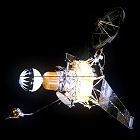 NASA launches the Ranger 3 lunar probe, built by Jet Propulsion Laboratory and intended to go directly to the moon, transmitting pictures of the surface back to Earth until it impacts the lunar surface. This modified Ranger spacecraft design also includes a balsa wood sphere, containing seismic detection experiments, which is intended to be blasted free of the main spacecraft and impact the moon separately. A problem with the Agena second stage booster puts Ranger 3 on the wrong heading with too much acceleration, missing the moon by 22,000 miles. With three straight failures to send a costly probe to the moon, NASA’s future and the future of its lunar exploration program is now under government review.
NASA launches the Ranger 3 lunar probe, built by Jet Propulsion Laboratory and intended to go directly to the moon, transmitting pictures of the surface back to Earth until it impacts the lunar surface. This modified Ranger spacecraft design also includes a balsa wood sphere, containing seismic detection experiments, which is intended to be blasted free of the main spacecraft and impact the moon separately. A problem with the Agena second stage booster puts Ranger 3 on the wrong heading with too much acceleration, missing the moon by 22,000 miles. With three straight failures to send a costly probe to the moon, NASA’s future and the future of its lunar exploration program is now under government review.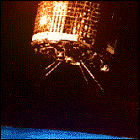 NASA and the United States Weather Bureau launch the fourth experimental TIROS weather satellite, TIROS-4. Further refinements to the basic TIROS satellite system are made, and after TIROS-3’s discovery of a hurricane in the Atlantic well before it his the US, new enhancements are introduced specifically for early hurricane detection. TIROS-4 remains in orbit for less than six months.
NASA and the United States Weather Bureau launch the fourth experimental TIROS weather satellite, TIROS-4. Further refinements to the basic TIROS satellite system are made, and after TIROS-3’s discovery of a hurricane in the Atlantic well before it his the US, new enhancements are introduced specifically for early hurricane detection. TIROS-4 remains in orbit for less than six months.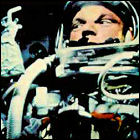 The third manned Mercury flight, Friendship 7, puts John Glenn in orbit for nearly five hours, the first American astronaut to circle the Earth. The retro-rocket package on Glenn’s vehicle, Friendship 7, becomes an issue when a sensor indicates that the heat shield protecting the capsule’s interior from the intense heat of reentry has slipped. Intended to be cast off before reentry, the retro package is left on at the insistence of ground controllers, resulting in an unusually rough ride home after only three orbits.
The third manned Mercury flight, Friendship 7, puts John Glenn in orbit for nearly five hours, the first American astronaut to circle the Earth. The retro-rocket package on Glenn’s vehicle, Friendship 7, becomes an issue when a sensor indicates that the heat shield protecting the capsule’s interior from the intense heat of reentry has slipped. Intended to be cast off before reentry, the retro package is left on at the insistence of ground controllers, resulting in an unusually rough ride home after only three orbits. The 147th episode of Sam Rolfe’s western series Have Gun – Will Travel is broadcast on CBS in the United States, starring Richard Boone. This episode is written by future Star Trek creator Gene Roddenberry.
The 147th episode of Sam Rolfe’s western series Have Gun – Will Travel is broadcast on CBS in the United States, starring Richard Boone. This episode is written by future Star Trek creator Gene Roddenberry. 